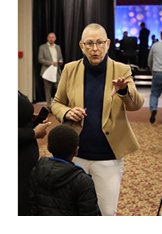Remembering To Stay Cognitively Limber While Avoiding Mental Muscle Fatigue In The Gym Of Life
Greetings *|FNAME|*,
 Since recovering (slowly!) from chemo, I've returned to the gym to build back my strength. But recouping takes time, no matter how much I try to increase my level of exercise. Being back in Houston for daily radiation treatments has personally reminded me that memory is an underrated, limited resource that no amount of exercise can expand. Instructional designers know why reducing cognitive load, or the amount of mental processing that occurs in our working memory, is key to helping us handle more situations and improve learning effectiveness.
Since recovering (slowly!) from chemo, I've returned to the gym to build back my strength. But recouping takes time, no matter how much I try to increase my level of exercise. Being back in Houston for daily radiation treatments has personally reminded me that memory is an underrated, limited resource that no amount of exercise can expand. Instructional designers know why reducing cognitive load, or the amount of mental processing that occurs in our working memory, is key to helping us handle more situations and improve learning effectiveness.
But why? Because all human working memory allows no more than 5 +/- 2 pieces of information, concepts, or mega-concepts to be held in our brain at one instant. For example: if you 1) have a high-powered or complex job that requires you to change your focus and effort frequently to new and different tasks, 2) you are struggling with a medical issue for your child, and 3) you're trying to quit smoking, that's a lot of cognitive load!
One way each of our human brains try to economize our memory usage is by finding patterns amidst seeming chaos. This way we can reduce the strain on our limited memory and focus on things that take up more of it. It's also why we create routines, so that some tasks become more automatic, chunking into concepts that don't require nearly as much attention. Leaders do a lot of that so they can be as efficient as possible, becoming adept at finding patterns in chaos while staying flexible with different people, their traits and personalities, as well as constantly changing situations.
 So what recently has reminded me that working memory is a resource that is always limited no matter how much practice we give it? Here in Houston, my current weekly regimen has about six key things I have to do, including:
So what recently has reminded me that working memory is a resource that is always limited no matter how much practice we give it? Here in Houston, my current weekly regimen has about six key things I have to do, including:
- radiation (5x/week)
- physical therapy appointments (2x/week)
- therapeutic yoga (3x/week)
- occupational therapy for neuropathy (1x/week)
- radiation oncologist visit (1x/week)
- aerobic and PT exercises every day
Plus there are immunotherapy infusions once every three weeks, and there's dealing with the shuttle, parking, and valet transportation consideration, because my appointments can also shift
on a daily basis. This, plus keeping the business going, all boils down to a lot of individual things to think about, some of which are constantly changing. The amount of variability pretty easily maxes out my short-term memory because I can't nail down a routine. As a result, I get a little grouchy... which Paul can unfortunately attest to.
Grouchiness is a common symptom of cognitive load hitting its limits. Grouchiness in learners is bad because it impacts performance by using up working memory and distracting people from what they are learning. In cases where we want learners to become automatic at performing a complex skill set, and we don't want to overload them to a high frustration point, we can apply Cognitive Flexibility Theory (CFT). By applying CFT, we can build training that requires learners to assemble a large number of concepts and skills performed during variable situations. These situations are called 'complex' or 'ill- structured domains'. In fact, in this type of scenario, learners are required to construct a mental structure that enables them to 'hang' the information and skills on that structure in a variable pattern. This leads to flexibility. Ultimately, CFT says there are no easy answers, and the path to achieving the goal depends on how the learner constructs their ability to perform the specific conglomeration of knowledge and skills to perform ill-structured, complex tasks.
 One of our state legislature projects was a good example of how CFT can be implemented. Legislative assistants to a state representative were required to learn three very complicated rule-based processes including: the legislative process, the budget appropriations process and the bill drafting process. Each process was a series of 'if this, then that' decisions. They had to learn that first, then combine the three processes, plus all related rules. This combining and additional variability took most staffers even more cognitive effort.
One of our state legislature projects was a good example of how CFT can be implemented. Legislative assistants to a state representative were required to learn three very complicated rule-based processes including: the legislative process, the budget appropriations process and the bill drafting process. Each process was a series of 'if this, then that' decisions. They had to learn that first, then combine the three processes, plus all related rules. This combining and additional variability took most staffers even more cognitive effort.
On top of that, they had to deeply understand how their representative would respond in a wide variety of circumstances. Also, the staffers had to know how they themselves would respond to different situations, based on the constellation of factors mentioned above. Both the representative and the legislative aide's decisions were heuristic-based, dependent on timing, preferences, roles, and the conditions on the ground. It's plain to see how easily a learner's working memory could be overloaded by so much variability. That's especially the case for these new staffers, who had to become fully competent in a highly compressed time frame. Talk about brain overload!
All that to say: don't beat yourself up if you miss a beat, especially while trying to do something new. More experience will definitely lead to more confidence and automaticity, which helps to free up that valuable working memory for other demands. Sitting here this afternoon in a slouch while writing, I'm reminded that I need to remember to consistently sit and stand in the new posture the PT has identified for me. Post-surgery, that change is necessary so that my body can properly heal and not regress. Sigh, one more thing to remember... but each day becoming the new norm and slowly, over time, becoming automatic.
As the Winter draws to a close and Spring approaches, I hope that the new things in your life are slowly settling into routine. But if not, just remember there are really only 5 +/- 2 things you can juggle right now anyhow – Doctor's orders 😉
Yours Truly,


Sue
Email | LinkedIn | V-Card